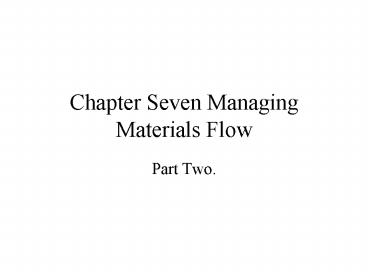Chapter Seven Managing Materials Flow PowerPoint PPT Presentation
1 / 33
Title: Chapter Seven Managing Materials Flow
1
Chapter Seven Managing Materials Flow
- Part Two.
2
Materials Management Activities
- Anticipating materials requirements
- Sourcing and obtaining materials
3
Materials Management Activities
- Anticipating materials requirements
- Sourcing and obtaining materials
- Introducing materials into the organization
4
Metals
Tube Supplier
5
Metals
Tube Supplier
6
Tube Supplier
Metals
7
Materials Management Activities
- Anticipating materials requirements
- Sourcing and obtaining materials
- Introducing materials into the organization
- Monitoring the status of materials as a current
asset
8
Objectives of Integrated Materials Management
9
Objectives of Integrated Materials Management
- Low costs
10
Objectives of Integrated Materials Management
- Low costs
- High level of service
11
Objectives of Integrated Materials Management
- Low costs
- High level of service
- Quality assurance
12
Objectives of Integrated Materials Management
- Low costs
- High level of service
- Quality assurance
- Low level of tied-up capital
13
Objectives of Integrated Materials Management
- Low costs
- High level of service
- Quality assurance
- Low level of tied-up capital
- Support of other functions
14
Differences Between Inbound and Outbound
Transportation
15
Differences Between Inbound and Outbound
Transportation
- Market demand that generates the need for
outbound movement is more uncertain and
fluctuating
16
Differences Between Inbound and Outbound
Transportation
- Market demand that generates the need for
outbound movement is more uncertain and
fluctuating - Inbound transportation tends to involve bulk raw
materials, supplies, or parts
17
Differences Between Inbound and Outbound
Transportation
- Market demand that generates the need for
outbound movement is more uncertain and
fluctuating - Inbound transportation tends to involve bulk raw
materials, supplies, or parts - Firms exercise less control over inbound
transportation due to total delivered pricing
programs
18
Types of Forecasts
19
Types of Forecasts
- Demand forecast
20
Types of Forecasts
- Demand forecast
- Long-term
21
Types of Forecasts
- Demand forecast
- Supply forecast
- Long-term
22
Types of Forecasts
- Demand forecast
- Supply forecast
- Long-term
- Midrange
23
Types of Forecasts
- Demand forecast
- Supply forecast
- Price forecast
- Long-term
- Midrange
24
Types of Forecasts
- Demand forecast
- Supply forecast
- Price forecast
- Long-term
- Midrange
- Short-term
25
Total Quality Management (TQM)
- the application of quantitative and human
resources to improve the material services
supplied to an organization, all the processes
within the organization, and the degree to which
the needs of customers are met - now and in the
future.
26
Total Quality Management
- Based upon continuous improvement.
- Uses quantitative and other analysis to determine
quality. - Based upon benchmarking us against other
organizations, us against ourselves.
27
Kanban Production Technique
- Kanban, Japanese for signboard.
- Small cards in manufacturing supply container.
Upon use of material, card is sent back to
supplier to indicate another container is needed. - Highly effective but simple information system.
28
Just-in-Time (JIT)
- Sometimes called Efficient Consumer Response,
ECR, (food industry) or Quick Response, QR,
(retailing). - Inventory is on hand just in time instead of just
in case.
29
Benefits Resulting from Implementing Just-in-Time
- Improved inventory turns.
- Improved customer service.
- Decreased warehouse space.
- Improved response time.
- Reduced logistics costs.
- Reduced transportation costs.
- Improved quality of vendor products.
- Reduced number of vendors.
- Reduced number of transportation carriers.
30
Materials Requirements Planning (MRP I)
- Computer-based manufacturing system to coordinate
manufacturing components and materials. - Operates on master scheduling technique to
improve manufacturing performance, reduce
inventory, and be more market oriented.
31
Manufacturing Resource Planning (MRP II)
- Computerized coordination of engineering,
finance, logistics, manufacturing, purchasing,
marketing. - Results in reduced inventory, higher inventory
turnover, better customer delivery, reduced
purchased costs and worker overtime.
32
Enterprise Resource Planning (ERP)
- Uses accounts payable, accounts receivable,
general ledger and logistics to coordinate
manufacturing and distribution.
33
Distribution Requirements Planning (DRP I and II)
- Include demand forecasts, purchase orders,
customer orders. - Pushes demand information backward to inform and
control the supply chain. - Coordinates MRP with logistics.

